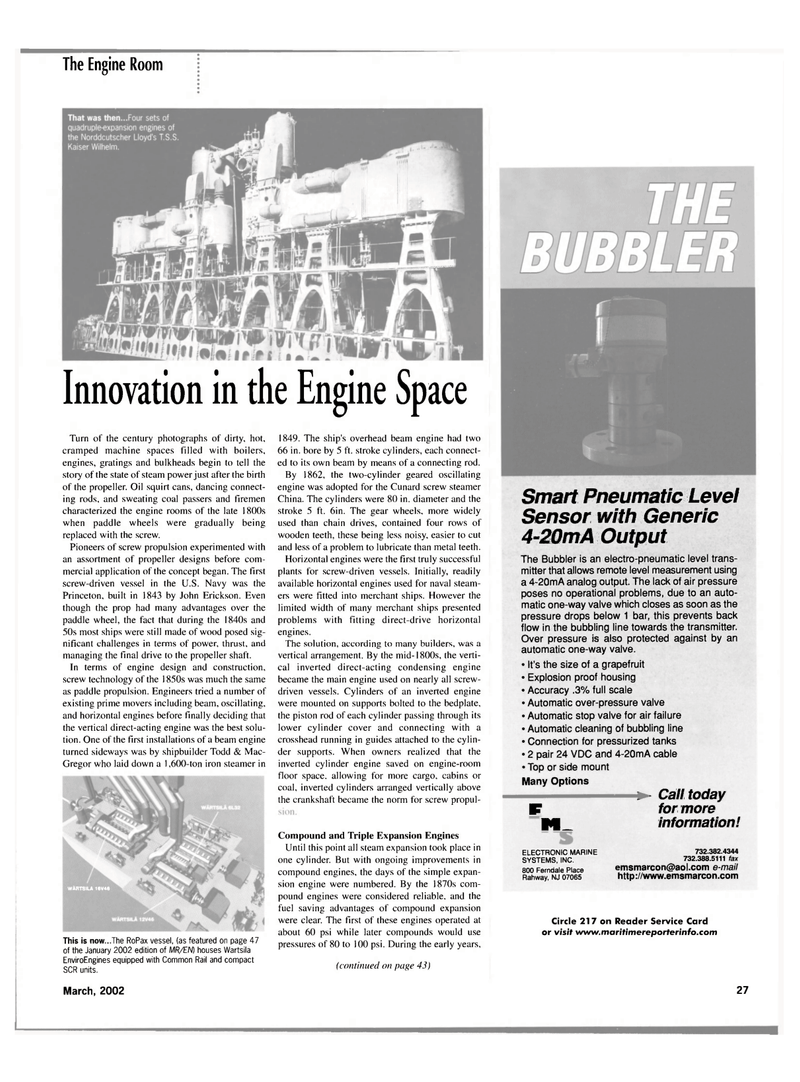
Page 27: of Maritime Reporter Magazine (March 2002)
Read this page in Pdf, Flash or Html5 edition of March 2002 Maritime Reporter Magazine
The Engine Room
Innovation in the Engine Space
Turn of the century photographs of dirty, hot, cramped machine spaces filled with boilers, engines, gratings and bulkheads begin to tell the story of the state of steam power just after the birth of the propeller. Oil squirt cans, dancing connect- ing rods, and sweating coal passers and firemen characterized the engine rooms of the late 1800s when paddle wheels were gradually being replaced with the screw.
Pioneers of screw propulsion experimented with an assortment of propeller designs before com- mercial application of the concept began. The first screw-driven vessel in the U.S. Navy was the
Princeton, built in 1843 by John Erickson. Even though the prop had many advantages over the paddle wheel, the fact that during the 1840s and 50s most ships were still made of wood posed sig- nificant challenges in terms of power, thrust, and managing the final drive to the propeller shaft.
In terms of engine design and construction, screw technology of the 1850s was much the same as paddle propulsion. Engineers tried a number of existing prime movers including beam, oscillating, and horizontal engines before finally deciding that the vertical direct-acting engine was the best solu- tion. One of the first installations of a beam engine turned sideways was by shipbuilder Todd & Mac-
Gregor who laid down a 1,600-ton iron steamer in
This is now...The RoPax vessel, (as featured on page 47 of the January 2002 edition of MR/EN) houses Wartsila
EnviroEngines equipped with Common Rail and compact
SCR units. 1849. The ship's overhead beam engine had two 66 in. bore by 5 ft. stroke cylinders, each connect- ed to its own beam by means of a connecting rod.
By 1862, the two-cylinder geared oscillating engine was adopted for the Cunard screw steamer
China. The cylinders were 80 in. diameter and the stroke 5 ft. 6in. The gear wheels, more widely used than chain drives, contained four rows of wooden teeth, these being less noisy, easier to cut and less of a problem to lubricate than metal teeth.
Horizontal engines were the first truly successful plants for screw-driven vessels. Initially, readily available horizontal engines used for naval steam- ers were fitted into merchant ships. However the limited width of many merchant ships presented problems with fitting direct-drive horizontal engines.
The solution, according to many builders, was a vertical arrangement. By the mid-1800s, the verti- cal inverted direct-acting condensing engine became the main engine used on nearly all screw- driven vessels. Cylinders of an inverted engine were mounted on supports bolted to the bedplate, the piston rod of each cylinder passing through its lower cylinder cover and connecting with a crosshead running in guides attached to the cylin- der supports. When owners realized that the inverted cylinder engine saved on engine-room floor space, allowing for more cargo, cabins or coal, inverted cylinders arranged vertically above the crankshaft became the norm for screw propul-
Compound and Triple Expansion Engines
Until this point all steam expansion took place in one cylinder. But with ongoing improvements in compound engines, the days of the simple expan- sion engine were numbered. By the 1870s com- pound engines were considered reliable, and the fuel saving advantages of compound expansion were clear. The first of these engines operated at about 60 psi while later compounds would use pressures of 80 to 100 psi. During the early years.
Smart Pneumatic Level
Sensor with Generic 4-20mA Output
The Bubbler is an electro-pneumatic level trans- mitter that allows remote level measurement using a 4-20mA analog output. The lack of air pressure poses no operational problems, due to an auto- matic one-way valve which closes as soon as the pressure drops below 1 bar, this prevents back flow in the bubbling line towards the transmitter.
Over pressure is also protected against by an automatic one-way valve. • It's the size of a grapefruit • Explosion proof housing • Accuracy .3% full scale • Automatic over-pressure valve • Automatic stop valve for air failure • Automatic cleaning of bubbling line • Connection for pressurized tanks • 2 pair 24 VDC and 4-20mA cable • Top or side mount
Many Options » Call today
W for more
M information!
ELECTRONIC MARINE
SYSTEMS, INC. 800 Ferndale Place
Rahway, NJ 07065 732.382.4344 732.388.5111 fax [email protected] e-mail http ://www.emsmarcon.com
Circle 217 on Reader Service Card or visit www.maritimereporterinfo.com (continued on page 43)
WARTSIL* 16V46
March, 2002 27

 26
26

 28
28
